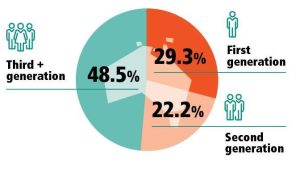First and second generation migrants now in the majority – ABS
The number Australians either born overseas or with one parent born overseas has risen above 50 per cent of the population for the first time since the colonial era, according to a new Australian Bureau of Statistics (ABS) snapshot report.
“The proportion of Australian residents that are born overseas (first generation) or have a parent born overseas (second generation) has moved above 50 per cent (51.5 per cent),” the snapshot says.
“The top five most commonly reported ancestries in the 2021 Census followed previous trends and included English at 33.0 per cent, Australian at 29.9 per cent, Irish at 9.5 per cent, Scottish at 8.6 per cent and Chinese at 5.5 per cent,” it says.
The report says Australia continues to be a culturally and linguistically diverse country with the growth of communities from Nepal, India, Pakistan, Iraq and the Philippines.
Mandarin continues to be the most common language other than English with 685,274 people using Mandarin at home.
This is followed by Arabic (367,159 people), Vietnamese (320,758 people), and Cantonese (295,281 people). Punjabi had the largest increase, with the 2021 Census showing 239,033 people using Punjabi at home.
Nepali featured in the top five languages used at home in both ACT (1.3 per cent) and Tasmania (1.3 per cent).
The report also reveals increased diversity of religious affiliation across the population.
 The percentage of Australian’s reporting no religious affiliation continues to grow. It’s now at 38.9 per cent of the population compared to 30.1 per cent in the 2016 Census.
The percentage of Australian’s reporting no religious affiliation continues to grow. It’s now at 38.9 per cent of the population compared to 30.1 per cent in the 2016 Census.
But Christianity remains the most common religion with 43.9 per cent of the population identifying as Christian, a decrease from 52.1 per cent in the 2016 Census.
The top 5 religions outside of Christianity are Islam, Hinduism, Buddhism, Sikhism and Judaism.
The religion question is voluntary in the Census, yet there was an increase in the proportion of people answering the question, from 91 per cent in 2016 to 93 per cent in 2021.
The snapshot also looks at the nation’s population in terms of age and distribution.
The median age of all Australians remains at 38 years in 2021. Males make up 49.3 per cent of the population with a median age of 37 years and females make up 50.7 per cent with a median age of 39 years.
Australia is undergoing a significant generational shift. Baby Boomers and Millennials each have over 5.4 million people, with only 5,662 more Baby Boomers than Millennials counted on 10 August 2021.
“Millennials (25-39 years) are of working age and are upskilling, representing 40 per cent of people attending vocational education, including TAFE, and 48 per cent of people currently serving in the regular service in the Australian Defence Force,” the report says.
“Baby Boomers (55-74 years) are providing care for other peoples’ children, often their grandchildren. Around one in eight (12.8 per cent) Baby Boomers reported caring for other peoples’ children, and of these, two thirds are female (67.5 per cent). They are also the generation most likely to volunteer and provide unpaid assistance to others.
“Generation Z (10-24 years old) represent 18 per cent of the Australian and 30 per cent of the Aboriginal and Torres Strait Islander population,” the report says.
It says almost 80 per cent of Australian residents live in eastern Australia in New South Wales, Victoria, Queensland and the Australian Capital Territory.
NSW continues to be the largest state with over 8 million people, with Victoria not far behind with 6.5 million people.
The ACT had the fastest growth with a 14.4 per cent (57,102 people) increase since 2016.
Almost 67 per cent of people counted were in the large capital cities and 33 per cent were in the rest of Australia.
Greater Sydney remains the largest city in Australia with 5.2 million people, followed by Melbourne with 4.9 million people and Brisbane with 2.5 million people.
See the full report here: Snapshot of Australia, 2021 | Australian Bureau of Statistics (abs.gov.au)












